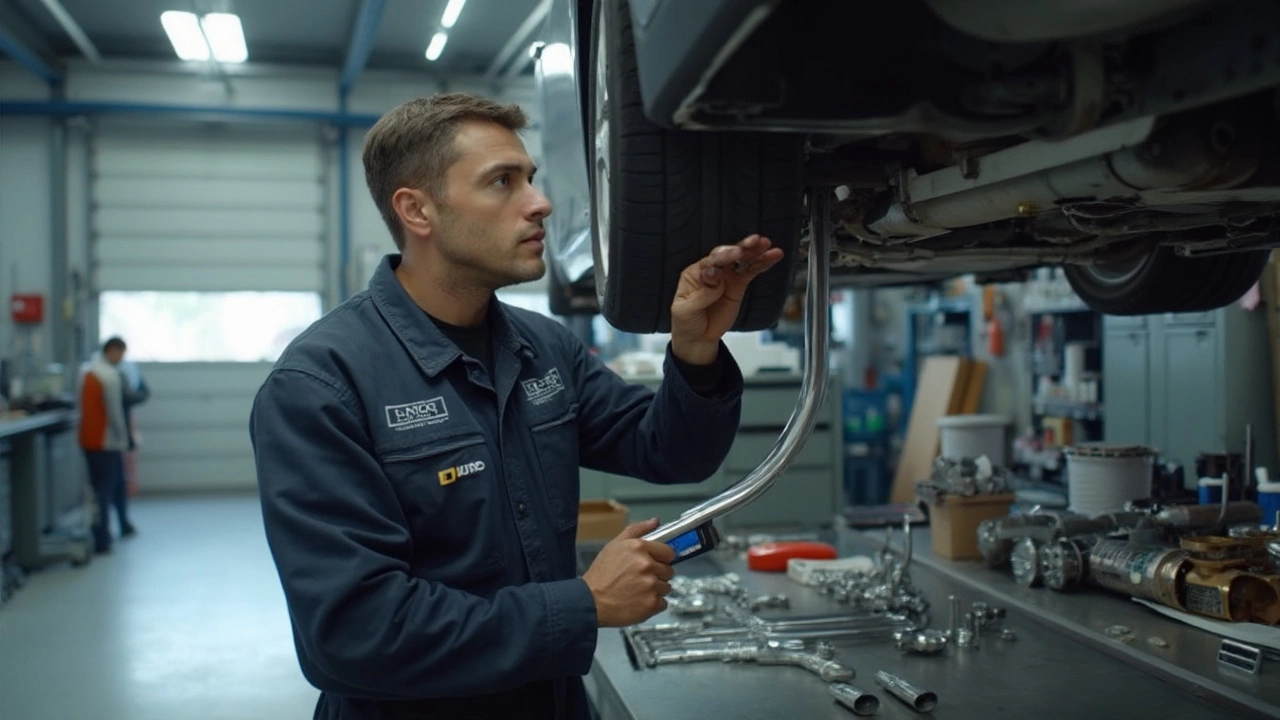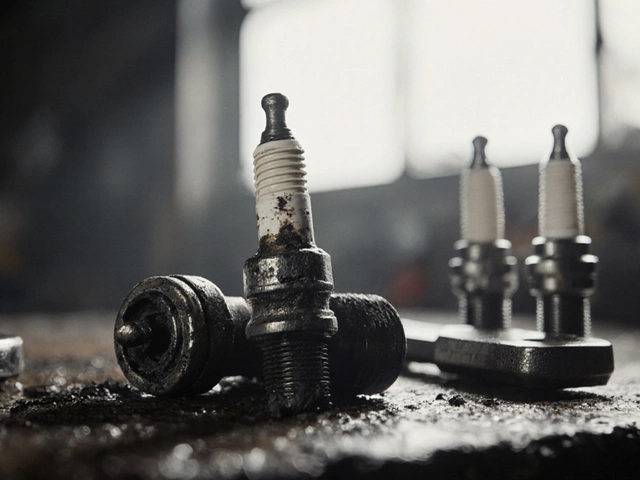Stand in any auto parts store and you’ll see a hundred shiny exhaust options, each promising better performance. But size really does matter—pick the wrong one, and you might choke your engine or lose precious horsepower. The truth is, bigger isn’t always better, even if your buddy swears it is.
The exhaust size you need boils down to a simple balance: get the gases out fast enough without killing your engine’s low-end power. Go too wide, and you’ll drop torque; go too narrow, and your car will feel sluggish or even overheat. So, how do you actually choose?
Start by looking up the recommended exhaust diameter for your specific make and engine size. Most stock sedans rock a 1.75" to 2.25" pipe, while a tuned V8 might need 2.5" or 3". Pay attention to horsepower too—there’s a real connection between exhaust flow and your engine’s breathing room.
- Why Exhaust Size Matters
- Measuring Up: Tools and Tricks
- Common Myths About Exhaust Sizing
- Practical Tips for Getting the Right Fit
Why Exhaust Size Matters
If you’ve read anything about picking the right exhaust size, you’ve probably heard it’s a big deal for both sound and power. But here’s what’s really happening: the diameter of your exhaust—whether it’s 1.75 inches or 3 inches—decides how fast the engine can push out exhaust gases. When that flow matches your engine’s needs, you get strong power and smoother running.
Bigger pipes mean easier flow, but it’s not so simple. If your exhaust system is too large for your engine, gases slow down and lose velocity, which can seriously hurt your low-end torque. That’s just a fancy way of saying your car might feel weaker off the line. With a pipe that’s too small, your engine struggles to push out gases, which can mess up performance, cause back pressure, and even make your engine run hot.
Here’s a quick breakdown of how different sizes usually work out for common car types:
| Engine Size/Type | Typical Exhaust Size (inches) | Purpose |
|---|---|---|
| 1.5L-2.0L (4-cylinder) | 1.75-2.25 | Stock/Light Mods |
| 2.5L-4.0L (V6/Small V8) | 2.25-2.5 | Moderate Mods/Performance |
| Big V8/Turbo (400+ HP) | 2.5-3.0 | High Performance |
Noise is part of the story, too. Got a huge exhaust system? You’ll probably wake up the neighbors. Smaller pipes keep things quieter.
One more thing: a mismatched exhaust size can even mess with your fuel economy. The engine has to work harder to compensate for blocked or badly flowing exhaust gases. In the end, getting the right fit means your car runs better, sounds better, and won’t burn extra cash at the pump.
Measuring Up: Tools and Tricks
Time to talk nuts and bolts—literally. Figuring out your actual exhaust size isn’t rocket science, but you do need a few basics. You’ll want a tape measure or a set of calipers (the digital ones make life easier). If you’re crawling under the car, make sure Rufus isn’t around to lick your face mid-task. Safety glasses aren’t a bad idea either—rust and road grime love to drop right in your eyes.
Don’t just trust your eyes—measure from the outside edge to the outside edge of the pipe. That’s called the "outside diameter" (OD), and it’s how most exhaust systems are sized. If you’re replacing a stock exhaust, write down the OD of the pipe coming off your catalytic converter. Aftermarket performance parts will always ask for this number when you’re ordering online.
- For most compact cars or sedans, the stock OD is usually between 1.75" and 2.25".
- Trucks and V8 muscle cars tend to run 2.5" or even 3" pipes.
- Don’t ignore bends or crushed sections—measure where the pipe is in its best shape.
Here’s a trick: If you’re thinking about boosting horsepower, use the general rule of thumb—add 0.1" to your OD for every 30 extra horses over stock. The right exhaust system size will help with flow, but don’t overshoot or you’ll hurt low-end grunt.
It’s not just about measuring, either. When shopping online, make sure to match up "ID" (inside diameter) and "OD" since some brands like to mix those numbers and it gets confusing fast. Here’s a quick cheat sheet:
| Engine HP | Single Exhaust OD | Dual Exhaust OD |
|---|---|---|
| Up to 150 | 1.75" | 1.5" |
| 150-200 | 2" | 1.75" |
| 200-300 | 2.25" | 2" |
| 300-400 | 2.5" | 2.25" |
Always double-check these numbers on the forums or with people who drive your exact car. No shame in taking a picture of your pipe and posting it for advice. The last thing you want is to blow cash on a system that doesn’t fit or tanks your car performance.

Common Myths About Exhaust Sizing
When it comes to picking an exhaust size, there’s a ton of junk advice floating around. You’ve probably heard guys say you should always go bigger or that two pipes work better than one. Sometimes, that advice does more harm than good.
The most common myth? "Bigger pipes always mean more power." Not true. While it’s tempting to slap on the fattest exhaust you can find, too big actually makes your car feel slow off the line. Here’s why: exhaust velocity drops, and your engine loses backpressure, especially in street cars. Unless you’re running a race engine that’s all about top end, a giant exhaust system won’t do much except make a lot of noise.
Another mistake: thinking a loud exhaust is a fast exhaust. Everyone loves a mean sound, but volume has almost nothing to do with real performance. You can have a deep rumble and still lose horsepower if the pipe isn’t sized right for your engine’s output.
Let’s bust these other myths with some quick facts:
- Dual exhausts aren’t always better than single for smaller engines—sometimes, they actually hurt flow.
- Cheap universal kits rarely match your car’s needs. The right fit means doing a bit of homework.
- Stock exhaust sizes are NOT just to meet emissions or keep things quiet. Manufacturers size pipes for actual engine performance, fuel economy, and noise control.
Check out this table on recommended exhaust size by horsepower range for some common setups:
| Horsepower (HP) | Exhaust Diameter (inches) |
|---|---|
| Up to 150 HP | 1.75" - 2" |
| 150-250 HP | 2" - 2.25" |
| 250-400 HP | 2.5" - 3" |
| 400+ HP | 3" and up |
Don’t let exhaust myths blow your money or waste your time. Focus on what your engine really needs, not what sounds cool at a car meet.
Practical Tips for Getting the Right Fit
Getting the right exhaust size for your ride isn’t just about looks or copying someone else’s build. Here’s the game plan to actually nail it, minus the guesswork.
- Don’t Skip the Research: Hit your owner's manual first for your car’s ideal exhaust system measurements. Automakers actually provide a range, especially for aftermarket tuning. No manual? Most manufacturers post digital specs online.
- Use a Tape Measure: If you’re swapping out an older pipe, physically measure both inside and outside diameters. Even a quarter inch off can make a real difference in fit and performance.
- Match It To Your Power Goals: If your engine’s stock or close to it, super-sized pipes are just wasted cash. Generally, a 2.25” pipe is good for engines under 200hp, 2.5” for 200–300hp, and 3”+ for high-performance builds. Don’t just go bigger for sound—it can actually rob low-end power.
- Pay Attention to Bends and Joints: Tight bends and rough welds can shrink the effective diameter of your exhaust system. Mandrel-bent pipes keep the flow steady, while crush-bent pipes squeeze down and cut flow rate.
- Ask Around: Local exhaust shops see all kinds of setups. They know what fits, what drones, and what fails inspection. Their advice is gold, especially if you’re unsure what’ll clear your suspension or heat shields.
Want actual numbers? Check out this quick reference table for common exhaust size and horsepower pairings:
| Engine Output | Recommended Exhaust Size |
|---|---|
| Up to 150hp | 1.75" - 2" |
| 150hp-250hp | 2.25" - 2.5" |
| 250hp-400hp | 2.5" - 3" |
| 400hp+ | 3" and up |
Another tip: think about noise. Bigger pipes can be way louder, which might sound cool at first but could drive you crazy—or get you tickets—after a week. If you’re aiming for performance with comfort, stick to the smallest size that handles your power level without creating backpressure.
Don’t forget about future upgrades. If you plan on adding a turbo or supercharger down the line, you’ll want to size up now so you don’t have to redo everything later. It’s better to be ready than to waste money doing it all a second time. Rufus, my dog, hates loud surprises—just saying, your pets and neighbors might too.






